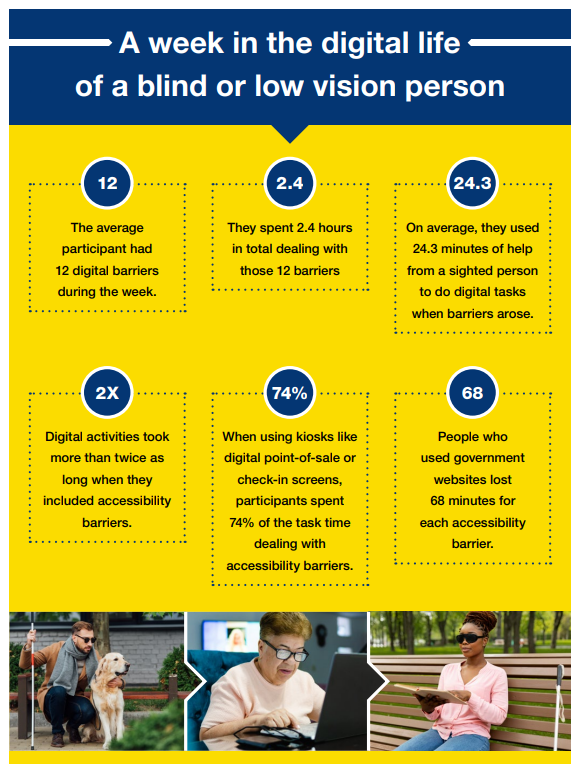Making Digital Information Available to All: Continuing the Story With American Foundation for the Blind’s Diary Study
People use websites, mobile apps, kiosks, and digital documents to accomplish many tasks. However, many of these digital tools are not accessible for people with disabilities. People who are blind or have low vision can have trouble buying things or getting services when companies use inaccessible digital tools.
About AFB’s research on this: In April of 2023, the American Foundation for the Blind (AFB) published a report from its Barriers to Digital Inclusion Survey. It showed that many people who are blind or have low vision face frequent problems using websites and mobile apps. In November 2023, AFB researchers built on these findings by having 20 people, all blind or low-vision, fill out daily diaries for 10 days. The participants told us how many times they used digital tools each day, and how many times they had an accessibility problem. Digital tools included websites, mobile apps, kiosks (like digital point-of-sale or check-in systems), and digital documents. The participants told us what they did to resolve accessibility problems, how long it took to fix or try to fix each problem, and whether or not they ended up doing the digital task they were hoping to get done.
What did the researchers learn? The infographic shows what participants reported during a typical week. As in the first study, the participants had accessibility problems almost every day that made it harder to get things done. Kiosks were especially hard to use, since they usually had touch screens without any screen reader or braille.
As in the first study, the participants had accessibility problems almost every day that made it harder to get things done.
A week in the digital life of a blind or low vision person
- The average participant had 12 digital barriers during the week.
- They spent 2.4 hours in total dealing with those 12 barriers.
- On average, they used 24.3 minutes of help from a sighted person to do digital tasks when barriers arose.
- Digital activities took more than twice as long when they included accessibility barriers.
- When using kiosks like digital point-of-sale or check-in screens, participants spent 74% of the task time dealing with accessibility barriers.
- People who used government websites lost 68 minutes for each accessibility barrier.
The participants also told us detailed stories about how digital accessibility problems affected their lives. One participant had trouble taking his daughter to a trampoline park because he couldn’t sign the digital waiver form without help. Another spent three hours booking a flight because she could not use the website and had to call the airline for help. Several participants also told us they just decided not to buy things online because the websites were too hard to use.
What changes does AFB recommend based on the research?
As in the first study, businesses, technology companies, schools, government agencies, and the federal government all have a responsibility to make digital systems accessible for people with disabilities.
- The federal government must enact and enforce laws and regulations that require digital accessibility for customers and employees with disabilities. This includes issuing regulations under the Americans with Disabilities Act and the Rehabilitation Act. The government should also provide free technical assistance to help organizations follow the law. It should set standards for making kiosks accessible. Finally, federal lawmakers should pass the Websites and Software Applications Accessibility Act to help businesses make their digital systems accessible.
- Businesses and organizations that use or make websites and applications should follow up-to-date accessibility standards. They should also hire website and software creators and managers who know how to build, maintain, and buy accessible digital technologies.
- Computer science teachers at universities must include accessibility lessons in all areas of their classes.
Glossary of Terms:
Accessible: When used to describe a website or app, it means that it can be used by people with disabilities the same way it is by people without disabilities. Accessible websites and apps let people with disabilities access the same information, engage in the same interactions, communicate as effectively, and enjoy the same services. They also provide the same privacy, independence, and ease of use.
Alt text: A written description of an image.
Digital inclusion: Making websites, mobile apps, and video programming accessible to people with disabilities.
Screen readers: Software that reads text out loud or uses a braille display so people who are blind, low vision, or deafblind can read a computer screen.
Download the Complete BDIS 2 Study
If you have any questions, please get in touch with our Public Policy and Research Institute at research@afb.org.
